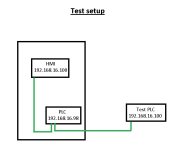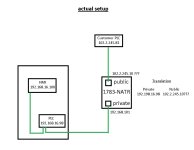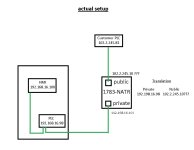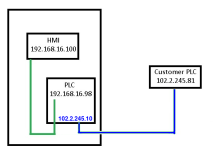Hi everybody,
I have a standard system with a PLC (1769-L16ER-BB1B) and a HMI (Panelview plus 7) that I want to integrate in a plant network.
The customer wants to exchange a couple of bits using produce and consume so I integrated everything already in our software.
I prepared and tested everything and it worked just fine.
My test setup was a our usual system (1769-L16ER-BB1B +Panelview plus 7) connected to another AB PLC to communicate with. Everything was connected as 1 network (see picture test setup).
Normally when we integrate something like this in a bigger network we just ask for 2 IP adresses for the PLC and HMI in the customer's network.
In this case the customer can only asign 1 IP adress (102.2.245.10) for our system to comunicate with their system (102.2.245.81).
I've been in touch with Rockwell Belgium and they told me I need a 1783-NATR to achieve this.
My question now is how do I set this up ?
I'm guessing the IP adress of the public IP adress will be the one that got assigned to us (102.2.245.10) ?
But what do I put in the translations as an public adress for my PLC with internal adress 192.168.16.98 ? (see picture actual setup)
I hope I can get some help this way, I'm just taking my first steps into AB programming.
Thanks a lot in advance


I have a standard system with a PLC (1769-L16ER-BB1B) and a HMI (Panelview plus 7) that I want to integrate in a plant network.
The customer wants to exchange a couple of bits using produce and consume so I integrated everything already in our software.
I prepared and tested everything and it worked just fine.
My test setup was a our usual system (1769-L16ER-BB1B +Panelview plus 7) connected to another AB PLC to communicate with. Everything was connected as 1 network (see picture test setup).
Normally when we integrate something like this in a bigger network we just ask for 2 IP adresses for the PLC and HMI in the customer's network.
In this case the customer can only asign 1 IP adress (102.2.245.10) for our system to comunicate with their system (102.2.245.81).
I've been in touch with Rockwell Belgium and they told me I need a 1783-NATR to achieve this.
My question now is how do I set this up ?
I'm guessing the IP adress of the public IP adress will be the one that got assigned to us (102.2.245.10) ?
But what do I put in the translations as an public adress for my PLC with internal adress 192.168.16.98 ? (see picture actual setup)
I hope I can get some help this way, I'm just taking my first steps into AB programming.
Thanks a lot in advance


Last edited:





